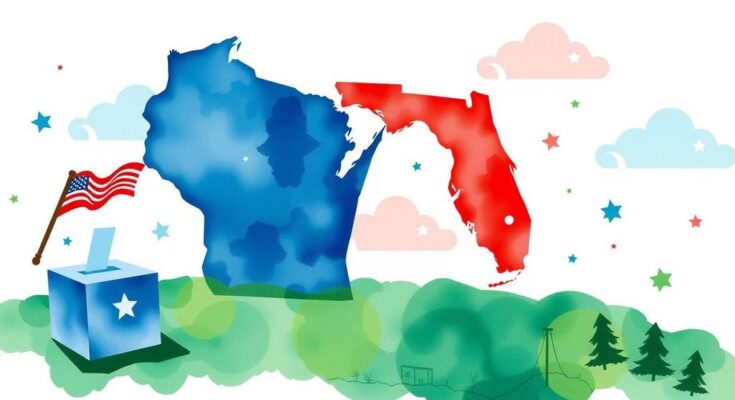Recent elections have sparked discussions about potential challenges for the Republican Party, particularly following pivotal outcomes in Wisconsin and Florida. The judicial election in Wisconsin saw significant financial commitments and garnered national attention, notably impacted by figures like Elon Musk. With midterm elections on the horizon, the implications of these results could shape the political landscape in ways not yet fully realized, particularly as both parties assess their strategies and public support moving forward.
Wisconsin Elections Imply Trouble for Trump and GOP
Recent elections, particularly the latest ones held in Wisconsin and Florida, have sent some unsettling signals to the Republican Party as they prepare for the upcoming midterms in 2026. In Wisconsin, the judicial race was particularly striking given the record amount of money spent and the heightened national attention. This election was somewhat a referendum tied to former President Trump’s agenda and notably involved Elon Musk, who poured a sizeable fortune into supporting the candidates. Meanwhile, Republicans also managed to secure victories in two special elections in Florida, albeit amidst concerns about their overall standing moving forward. This dichotomy of outcomes has led to significant discussion within political circles about the future of both major parties.
Elon Musk’s Influence Takes a Hit
The Wisconsin Supreme Court race was highlighted by the victory of liberal judge Susan Crawford, who fended off her opponent decisively, winning by 10 points. This result is particularly alarming for Republicans, especially considering that much of the campaign was driven by nearly $70 million in advertisements. The ad tracking firm AdImpact has stated this expenditure is the most ever recorded for a judicial election. While Republicans celebrated their two special election wins in Florida, their previous commanding leads were notably diminished. This points to potential vulnerabilities, particularly for the 60 Republican House members who won by close margins in the last election, leaving them anxious about their reelection prospects.
Democratic Strategy and Base Mobilization
Elon Musk’s involvement in the Wisconsin race was extensive, with about $20 million said to be spent on efforts to shape the election in favor of his preferred candidates. Musk even made an appearance in Wisconsin, notably donning a cheese hat and offering hefty sums of money as incentives. However, despite these efforts, the results were not favorable, and his reputation appears to have taken a hit along with it. As Trump’s ally, Musk has been seen as instrumental in championing certain agendas, but following this latest electoral setback, questions arise regarding his ongoing influence. Historically unpopular trade measures have not helped his standing either, muddying the waters for Trump as he tries to position himself positively following the elections.
Financial Resources and Voter Turnout in Key Races
On the Democratic side, there is a palpable sense of urgency within the party base. The party’s internal dynamics currently reflect a struggle between activism versus complacency. Recent actions, such as Senator Cory Booker’s lengthy anti-Trump speech, underline a preference among Democrats for a more combative approach against Republican policies. Activists are increasingly vocal, pushing party leadership to take a firmer stand against potential setbacks and voicing their dissatisfaction with Democratic inaction. This rift might be indicative of a broader sentiment among voters, suggesting that enthusiasm and proactivity may be key to the Democrats’ success leading into the next elections, as indicated by Wisconsin’s recent outcomes.
Voter ID Measures Still Popular Among Electorate
The significant investment of funds in both the Wisconsin and Florida races highlights the crucial role of financial support in off-cycle elections. The staggering $70 million spent in the Wisconsin judicial race emphasizes how much can hinge on mobilizing voter turnout. Even in a state with solid Democratic support, voter turnout was lower than in a presidential election year, with approximately 2.4 million ballots cast—about 30% lower than in the 2024 presidential election. This drop in voter turnout underscores the continuing necessity of energizing the base. Furthermore, the trend showing more college-educated voters aligning with Democrats may signal a longer-term shift that could influence future elections significantly.
Key Takeaways for Parties Moving Forward
Lastly, the approval of a voter ID measure in Wisconsin amid the judicial election results illustrates a paradox for Democrats. While they succeeded in electing a liberal judge, these same voters supported tightening voter ID laws, which is a topic that consistently polls well, even with some Democratic backing. This complexity indicates that while Democrats may have gained a crucial victory, they cannot afford to overlook issues like voter ID that resonate firmly with conservative voters. With polling showing that over 80% of voters favor showing ID at the polls, it is clear that the dynamics of voter preferences remain mixed, leaving parts of the electorate still aligned with traditional Republican ideals, despite recent Democratic successes.
What implications do these election results have for Republicans?
Following the elections, it seems the Republican Party faces challenges, particularly regarding Trump’s influence as indicated by mixed results across key states. Looking ahead to the midterms, this might signal a need for reevaluation of strategies within the party.
How are Democrats interpreting their victories?
In the wake of the recent elections, many Democrats see these results as evidence that their strategies of mobilization and fighting back against Republican policies are working. Activism within the party is gaining momentum, which could bode well for future elections.
What role did financial resources play in these elections?
Although voter turnout was lower in these off-cycle elections compared to presidential cycles, both parties invested heavily to ensure their bases were activated. The funding aimed at boosting turnout highlights the gambling aspect of spending versus actual voter engagement in these elections.
What does the election signify for Elon Musk’s political standing?
Elon Musk’s political capital appears to be waning post-election, especially as the results did not favor his supported candidates. This might influence Trump’s strategies as the elections have shown shifts in public sentiment against some of Musk’s approaches, hinting at changing alliances.
Does voter ID support impact Democratic strategies?
Even with successes, Democrats must acknowledge that important issues, like voter ID, have bipartisan support. This could complicate their platforms if they aim to attract a wider voter base while adhering to progressive ideals.




